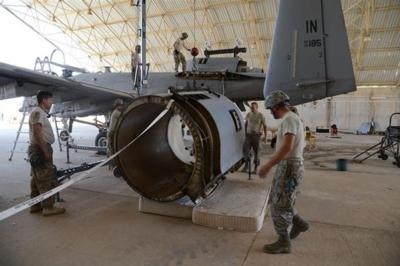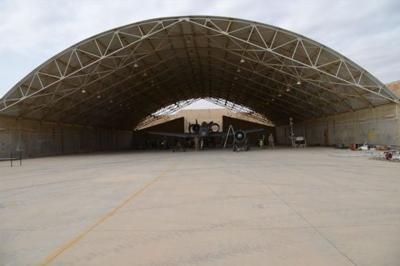Number One Engine Failed During Refueling Mission
A maintenance repair team from the 332nd Expeditionary Maintenance Squadron recently responded to an A-10C Thunderbolt II that suffered a noncombat-related engine failure and had to divert to Al Asad Air Base, Iraq.

The jet’s number one engine suffered catastrophic damage during a routine refueling mission and the pilot was able to safely land the aircraft at the air base.
Within hours, a nine-person team was headed to Iraq to identify damage and prepare a list of parts needed to expedite repairs. The task would require the maintainers to be on the ground for days, said Chief Master Sgt. Richard Stroh, the 386th EMXG team lead.
Initially, the team thought they would have to order parts from the U.S., grounding the aircraft for almost a month, but that was not an acceptable scenario for U.S. Air Forces Central Command and 332nd Air Expeditionary Group leadership.
“This was a very important mission,” said Col. Michael Stohler, the 332nd AEG commander. “The aircraft was in a location that was not fully secure and we needed it repaired and flown out of there as quickly as possible. It was the deputy combined forces air component commander’s number one priority.”
Stroh took the task of getting the aircraft fixed and in the air as soon as possible. “They asked that, if given all the parts, how long to repair the jet to a flyable condition,” he said. “I called a meeting of the team, where we established what needed to be done, and then figured an estimated time for completion for each major event. We needed seven more personnel and parts – we figured it would take five days to repair.”
With daily missions bringing parts and any other assets needed for the repairs, the maintenance repair team worked with their home unit and coordinated with local leadership to facilitate equipment and logistical needs.
Air Force assets and a Marine Corps unit stationed with the 332nd AEG provided airlift to the team. Stroh said their support was indispensable for providing the personnel and parts they needed to get the aircraft back in the air.
The job did not come without challenges. In addition to the constant airlift required for parts, the team had to be creative in both moving the aircraft and setting up a temporary work area. “Communicating fighter aircraft needs to Marine and Army personnel presented many unique challenges,” Stroh said. “There is absolutely no aircraft maintenance equipment, air ground equipment, or any way to tow fighter aircraft. We had to bring everything we needed and improvise everything else. We worked on the jet in an unused aircraft shelter the Iraqi air force used once upon a time. It had no lights, no power, no phone, and no Internet … just a roof over our heads.”

While the team could tow the aircraft across the flightline to the hangar, they didn’t have the right equipment to safely back it up in order to start the maintenance. This required some old fashioned manpower. “We used a medium tactical vehicle replacement seven-ton, all-wheel drive, 6x6 truck to get it to the hangar,” the chief said. “We tried to back it in using the truck … no joy. We tried to use a large Marine forklift to push it in … no joy. In the end, 12 Airmen and two Marines pushed the 40,000-pound aircraft 70 yards uphill into the hangar.”
The maintainers also faced the challenge of working at night without any light, but quickly discovered a solution to that problem too. “We found an abandoned light cart that belonged to the Marines,” Stroh said. “It was unused and had no battery. We found some 10-gauge wire in the hangar, stripped the ends and held them in place by hand to jump start the motor.”
Stohler said what the maintenance team accomplished was very significant, especially with the challenges and limitations they faced. “This fix required removing and replacing multiple major components on the aircraft that are normally not done,” he said. “It was accomplished in hot weather at a base with minimal support structure. The maintenance personnel slept 16 in a tent. There were no shower facilities. They worked long hours with minimal equipment to rebuild this aircraft, test it, and then fly it out."
Stohler added that the team was able to accomplish a task initially estimated to take weeks in just five days. “This was a great team effort,” he said. “The pilot did an outstanding job of flying this difficult to handle aircraft to a safe landing. The maintenance team did an awesome job of returning it to the air.”
(USAF Images)
 Bolen Gives Congress a Rare Thumbs-Up
Bolen Gives Congress a Rare Thumbs-Up The SportPlane Resource Guide RETURNS!!!!
The SportPlane Resource Guide RETURNS!!!! Buying Sprees Continue: Textron eAviation Takes On Amazilia Aerospace
Buying Sprees Continue: Textron eAviation Takes On Amazilia Aerospace Hawker 4000 Bizjets Gain Nav System, Data Link STC
Hawker 4000 Bizjets Gain Nav System, Data Link STC Echodyne Gets BVLOS Waiver for AiRanger Aircraft
Echodyne Gets BVLOS Waiver for AiRanger Aircraft




